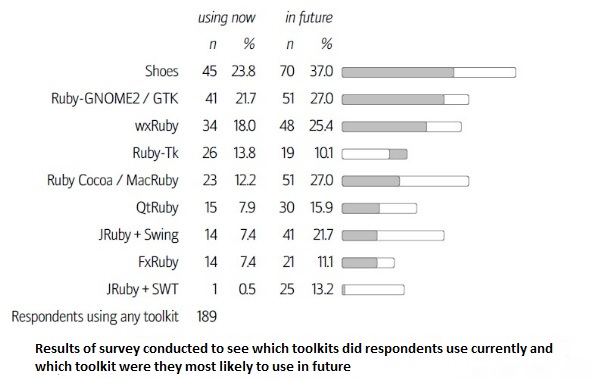CSC/ECE 517 Spring 2013/ch1a c ct
Overview
Ruby as a programming language has gained popularity in recent years, mainly due to the Rails web framework. There actually exists quite a few graphical user interface toolkits/frameworks for Ruby so that desktop GUI applications can be created. Two previous articles have made detailed comparisons between different toolkits by looking at various factors such as ease of installation, documentation, look and feel, and difficulty of usage. This article will give updates on GUI toolkits that has developed since the previous articles were written, as well as discuss any toolkits that were not present in the previous articles.
Current State of GUI Toolkits for Ruby
The Ruby Toolbox, a website that tracks the popularity of Ruby related tools by usage in open source projects, has a list of several toolkits under its "GUI Frameworks" category. The ranking in current popularity of GUI toolkits is as follows:
- Shoes
- FxRuby
- wxRuby
- QtBindings
- Ruby-GNOME2/GTK
- monkeybars
- FFI::Tk
The above list is by no means supposed to be a comprehensive list of toolkits that are available. However, it does give good indication as to which toolkit is currently being used the most frequently.
Now let's compare the current result to the 2008 Ruby GUI Survey's answer to the question "Which of the GUI toolkits do you currently use, and which do you think it's likely you'll use in the future?"

- Shoes
- Ruby-GNOME2/GTK
- wxRuby
- Ruby-Tk
- Ruby Cocoa/MacRuby
- QtRuby
- JRuby + Swing
- FxRuby
- JRuby + SWT
Visual Ruby
Visual Ruby is designed to simplify the process of adding a GTK+ windows to Ruby applications. It is also designed to completely integrate with the Glade user interface designer.